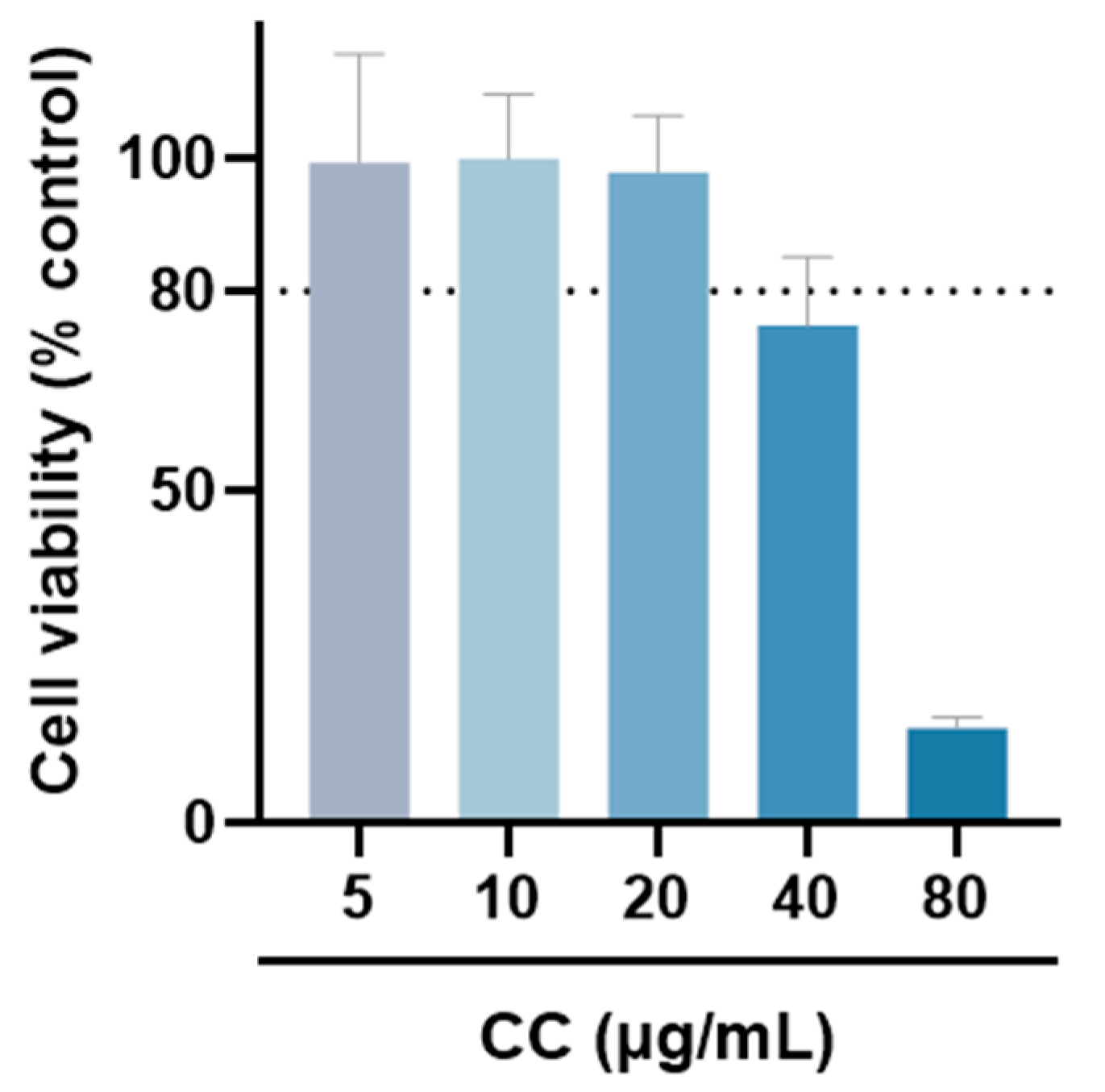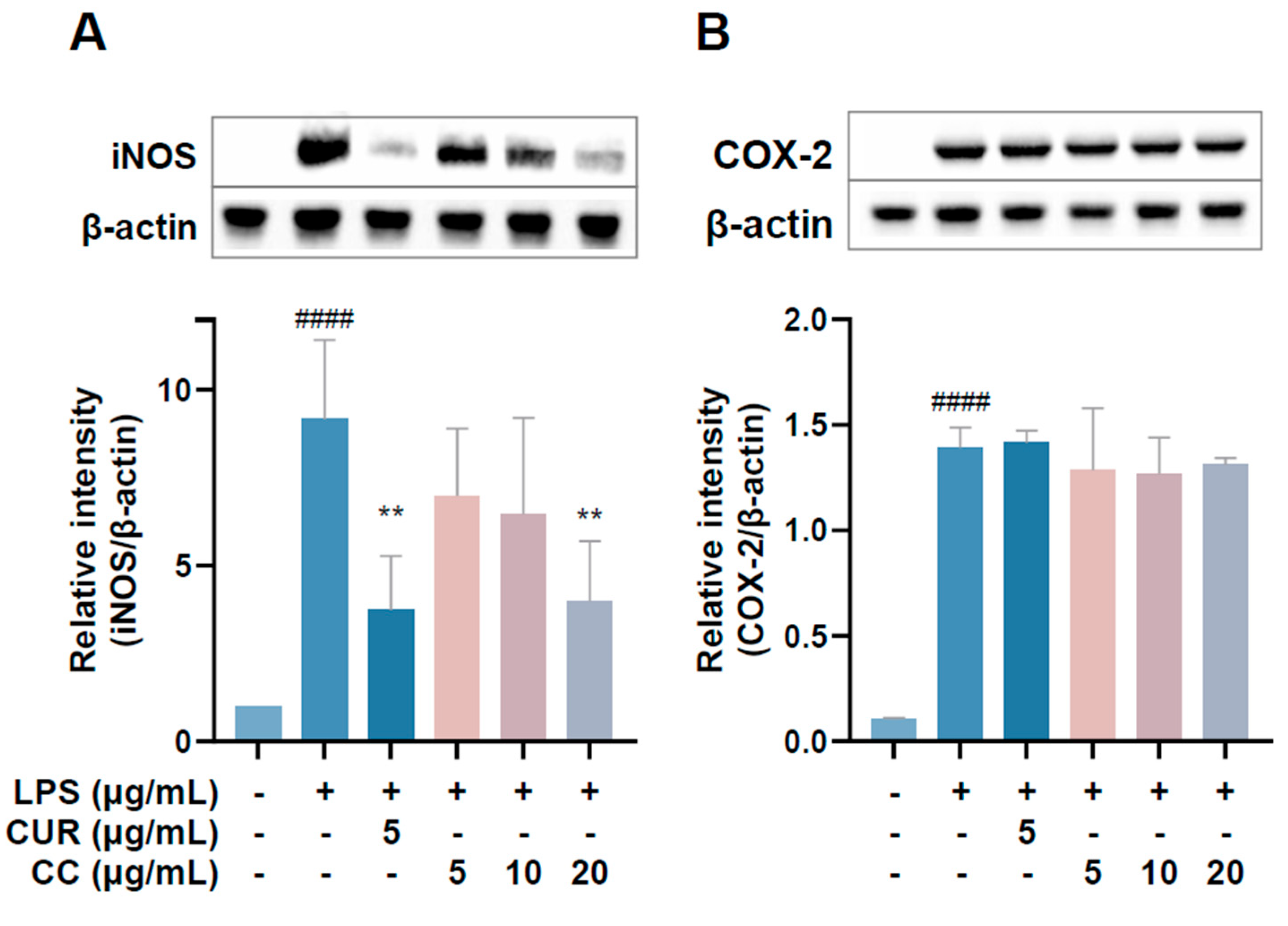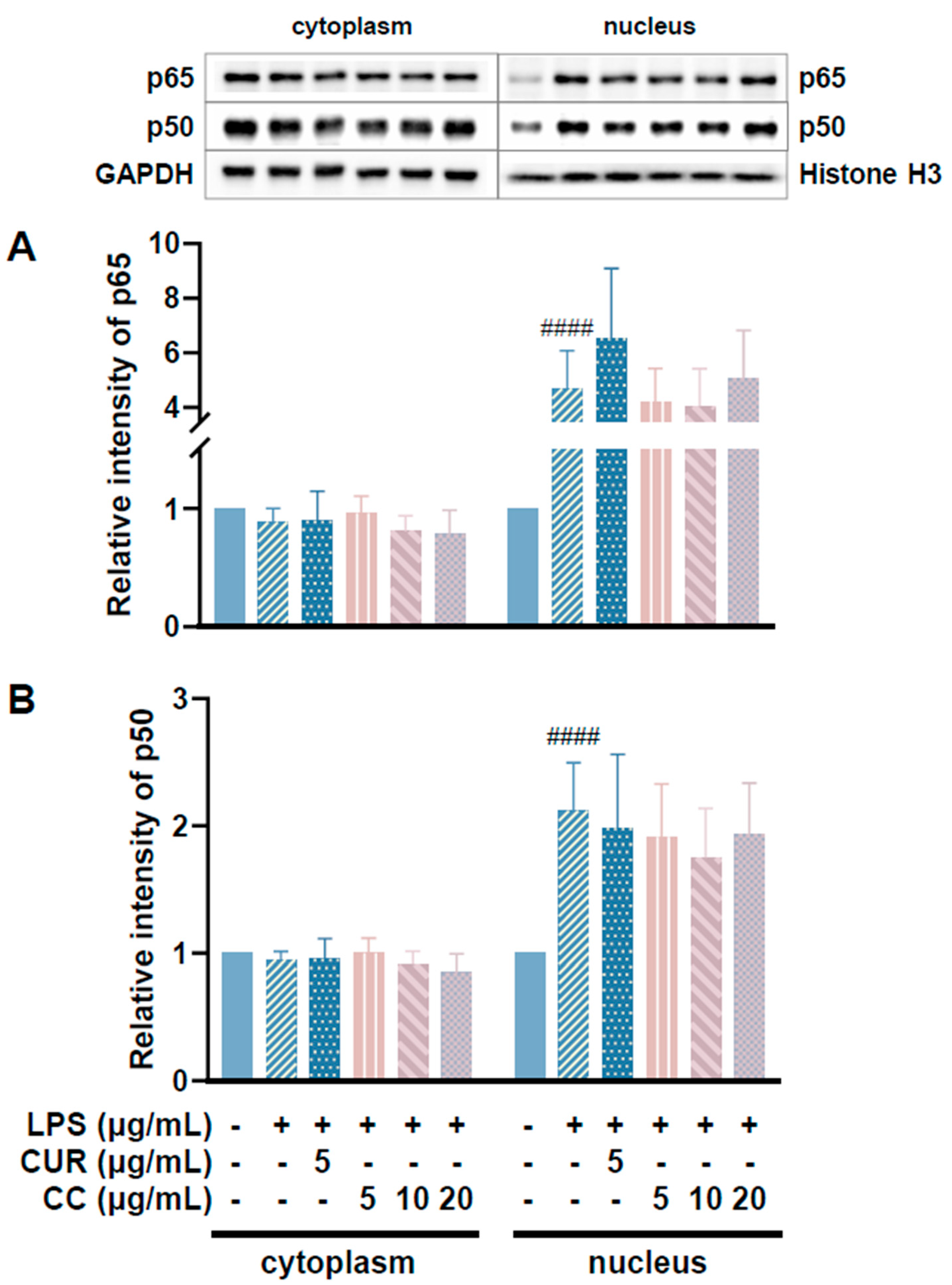Composition Characterization of Crossostephium chinense Leaf Essential Oil and Its Anti-Inflammatory Activity Mechanisms
Abstract
:1. Introduction
2. Results and Discussion
2.1. Chemical Composition of C. chinense Essential Oil (CCEO)
2.2. New Compounds Come from CCEO by HPLC and NMR
2.3. Anti-Inflammatory Activity of CCEO
2.4. Effect of CCEO on Pro-Inflammatory-Related Factors Induced by LPS in RAW264.7 Cells
2.5. Effect of CCEO on iNOS and COX-2 Protein in LPS-Induced RAW264.7 Cells
2.6. Effects of CCEO on MAPK and NF-κB Pathway Expression
2.7. Effect of CCEO on the Expression of NRF2 Transcription Factor
3. Materials and Methods
3.1. Plant Materials
3.2. Preparation of CCEO and GC/MS Analysis
3.3. Unknown Compound Identification by High-Performance Liquid Chromatography (HPLC) and Nuclear Magnetic Resonance Spectroscopy (NMR)
3.4. Cell Culture and Cell Survival Assay
3.5. Anti-Inflammatory Measurement
3.5.1. Nitric Oxide (NO) Assay
3.5.2. Prostaglandin E2 (PGE2), TNF-α, IL-1β, and IL-6 Assays
3.5.3. Reactive Oxygen Species (ROS) Assay
3.6. RNA Isolation and Quantitative Reverse Transcription PCR (qPCR)
3.7. Protein Extraction and Western Blot Analysis
3.8. Statistical Analysis
4. Conclusions
Supplementary Materials
Author Contributions
Funding
Data Availability Statement
Conflicts of Interest
References
- Lee, D.; Kwak, H.J.; Kim, B.H.; Kim, S.H.; Kim, D.W.; Kang, K.S. Combined Anti-Adipogenic Effects of Hispidulin and p-Synephrine on 3T3-L1 Adipocytes. Biomolecules 2021, 11, 1764. [Google Scholar] [CrossRef] [PubMed]
- Chang, T.N.; Huang, G.J.; Ho, Y.L.; Huang, S.S.; Chang, H.Y.; Chang, Y.S. Antioxidant and antiproliferative activities of Crossostephium chinensis (L.) Makino. Am. J. Chin. Med. 2009, 37, 797–814. [Google Scholar] [CrossRef] [PubMed]
- Wu, Q.; Yang, X.; Zou, L.; Fu, D. Bioactivity guided isolation of alpha-glucosidase inhibitor from whole herbs of Crossostephium chinense. Zhongguo Zhong Yao Za Zhi = Zhongguo Zhongyao Zazhi = China J. Chin. Mater. Med. 2009, 34, 2206–2211. [Google Scholar]
- Wang, Z.; Yamano, Y.; Kawakami, S.; Al-Hamoud, G.A.; Sugimoto, S.; Otsuka, H.; Matsunami, K. New ψ-Santonin Derivatives from Crossostephium chinense and Their Anti-Proliferative Activities against Leishmania major and Human Cancer Cells A549. Molecules 2023, 28, 8108. [Google Scholar] [CrossRef]
- Uehara, A.; Kitajima, J.; Kokubugata, G.; Iwashina, T. Further characterization of foliar flavonoids in Crossostephium chinense and their geographic variation. Nat. Prod. Commun. 2014, 9, 163–164. [Google Scholar] [CrossRef]
- Wu, Q.; Zou, L.; Yang, X.W.; Fu, D.X. Novel sesquiterpene and coumarin constituents from the whole herbs of Crossostephium chinense. J. Asian Nat. Prod. Res. 2009, 11, 85–90. [Google Scholar] [CrossRef]
- Huang, H.T.; Lin, C.C.; Kuo, T.C.; Chen, S.J.; Huang, R.N. Phytochemical composition and larvicidal activity of essential oils from herbal plants. Planta 2019, 250, 59–68. [Google Scholar] [CrossRef]
- Yatoo, M.I.; Gopalakrishnan, A.; Saxena, A.; Parray, O.R.; Tufani, N.A.; Chakraborty, S.; Tiwari, R.; Dhama, K.; Iqbal, H.M.N. Anti-Inflammatory Drugs and Herbs with Special Emphasis on Herbal Medicines for Countering Inflammatory Diseases and Disorders-A Review. Recent. Pat. Inflamm. Allergy Drug Discov. 2018, 12, 39–58. [Google Scholar] [CrossRef]
- Salvemini, D.; Kim, S.F.; Mollace, V. Reciprocal regulation of the nitric oxide and cyclooxygenase pathway in pathophysiology: Relevance and clinical implications. Am. J. Physiol. Regul. Integr. Comp. Physiol. 2013, 304, R473–R487. [Google Scholar] [CrossRef]
- Vishnupriya, P.; Aparna, A.; Viswanadha, V.P. Lipoxygenase (LOX) Pathway: A Promising Target to Combat Cancer. Curr. Pharm. Des. 2021, 27, 3349–3369. [Google Scholar] [CrossRef]
- Zhang, C.; Chen, S.; Zhang, Z.; Xu, H.; Zhang, W.; Xu, D.; Lin, B.; Mei, Y. Asiaticoside Alleviates Cerebral Ischemia-Reperfusion Injury via NOD2/Mitogen-Activated Protein Kinase (MAPK)/Nuclear Factor kappa B (NF-κB) Signaling Pathway. Med. Sci. Monit. Int. Med. J. Exp. Clin. Res. 2020, 26, e920325. [Google Scholar] [CrossRef] [PubMed]
- Xin, P.; Xu, X.; Deng, C.; Liu, S.; Wang, Y.; Zhou, X.; Ma, H.; Wei, D.; Sun, S. The role of JAK/STAT signaling pathway and its inhibitors in diseases. Int. Immunopharmacol. 2020, 80, 106210. [Google Scholar] [CrossRef] [PubMed]
- Miguel, M.G. Antioxidant and anti-inflammatory activities of essential oils: A short review. Molecules 2010, 15, 9252–9287. [Google Scholar] [CrossRef] [PubMed]
- Gao, Y.; Bai, D.; Zhao, Y.; Zhu, Q.; Zhou, Y.; Li, Z.; Lu, N. LL202 ameliorates colitis against oxidative stress of macrophage by activation of the Nrf2/HO-1 pathway. J. Cell. Physiol. 2019, 234, 10625–10639. [Google Scholar] [CrossRef] [PubMed]
- Aziz, Z.A.A.; Ahmad, A.; Setapar, S.H.M.; Karakucuk, A.; Azim, M.M.; Lokhat, D.; Rafatullah, M.; Ganash, M.; Kamal, M.A.; Ashraf, G.M. Essential Oils: Extraction Techniques, Pharmaceutical And Therapeutic Potential-A Review. Curr. Drug Metab. 2018, 19, 1100–1110. [Google Scholar] [CrossRef]
- Liu, K.; Rossi, P.G.; Ferrari, B.; Berti, L.; Casanova, J.; Tomi, F. Composition, irregular terpenoids, chemical variability and antibacterial activity of the essential oil from Santolina corsica Jordan et Fourr. Phytochemistry 2007, 68, 1698–1705. [Google Scholar] [CrossRef]
- Kumar, P.; Nagarajan, A.; Uchil, P.D. Analysis of Cell Viability by the MTT Assay. Cold Spring Harb. Protoc. 2018, 2018, pdb-prot095505. [Google Scholar] [CrossRef]
- Lin, C.T.; Chen, C.J.; Lin, T.Y.; Tung, J.C.; Wang, S.Y. Anti-inflammation activity of fruit essential oil from Cinnamomum insularimontanum Hayata. Bioresour. Technol. 2008, 99, 8783–8787. [Google Scholar] [CrossRef]
- Cui, J.; Jia, J. Natural COX-2 Inhibitors as Promising Anti-inflammatory Agents: An Update. Curr. Med. Chem. 2021, 28, 3622–3646. [Google Scholar] [CrossRef]
- Yang, L.; Cao, L.; Li, C.; Li, X.; Wang, J.; Chen, H.; He, J. Hostaflavone A from Hosta plantaginea (Lam.) Asch. blocked NF-κB/iNOS/COX-2/MAPKs/Akt signaling pathways in LPS-induced RAW 264.7 macrophages. J. Ethnopharmacol. 2022, 282, 114605. [Google Scholar] [CrossRef]
- Lee, J.A.; Song, H.Y.; Ju, S.M.; Lee, S.J.; Kwon, H.J.; Eum, W.S.; Jang, S.H.; Choi, S.Y.; Park, J.S. Differential regulation of inducible nitric oxide synthase and cyclooxygenase-2 expression by superoxide dismutase in lipopolysaccharide stimulated RAW 264.7 cells. Exp. Mol. Med. 2009, 41, 629–637. [Google Scholar] [CrossRef] [PubMed]
- Hazra, S.; Batra, R.K.; Tai, H.H.; Sharma, S.; Cui, X.; Dubinett, S.M. Pioglitazone and rosiglitazone decrease prostaglandin E2 in non-small-cell lung cancer cells by up-regulating 15-hydroxyprostaglandin dehydrogenase. Mol. Pharmacol. 2007, 71, 1715–1720. [Google Scholar] [CrossRef] [PubMed]
- Tai, H.H.; Tong, M.; Ding, Y. 15-hydroxyprostaglandin dehydrogenase (15-PGDH) and lung cancer. Prostaglandins Other Lipid Mediat. 2007, 83, 203–208. [Google Scholar] [CrossRef]
- Yin, L.; Wei, X.; Zhang, Y.; Lu, C.; Wang, H. Citrulline inhibits LPS-induced pyroptosis of RAW264.7 macrophages through NF-κB signaling pathway. Immun. Inflamm. Dis. 2023, 11, e832. [Google Scholar] [CrossRef]
- Chen, L.; Deng, H.; Cui, H.; Fang, J.; Zuo, Z.; Deng, J.; Li, Y.; Wang, X.; Zhao, L. Inflammatory responses and inflammation-associated diseases in organs. Oncotarget 2018, 9, 7204–7218. [Google Scholar] [CrossRef] [PubMed]











| NAME | Concentration (%) | KI a | Identification b |
|---|---|---|---|
| Santolina triene | 13.73 | 902 | MS/KI/ST |
| β-Myrcene | 0.78 | 996 | MS/KI/ST |
| p-Cymene | 0.72 | 1025 | MS/KI/ST |
| Limonene | 0.61 | 1030 | MS/KI/ST |
| 1,8-Cineole | 13.53 | 1033 | MS/KI/ST |
| trans-Chrysanthemol | 1.61 | 1158 | MS/KI/ST |
| Chrysanthemyl acetate | 2.74 | 1268 | MS/KI/ST |
| α-Copaene | 0.98 | 1373 | MS/KI/ST |
| 1-Acetoxy-2-(2-hydroxypropyl)-5-methylhex-3,5-diene | 0.23 | 1387 | MS/ST/KI |
| 1-Acetoxy-isopyliden-hex-5-en-4-one | 2.6 | 1397 | MS/ST/KI |
| trans-Caryophyllene | 3.29 | 1416 | MS/KI/ST |
| Allo-aromadendrene | 0.62 | 1453 | MS/KI |
| α-Gurjunene | 0.81 | 1472 | MS/KI |
| Germacrene D | 10.67 | 1478 | MS/KI/ST |
| α-Muurolene | 1.02 | 1495 | MS/KI/ST |
| γ-Cadinene | 0.46 | 1509 | MS/KI/ST |
| Cubebol | 5.79 | 1515 | MS/KI/ST |
| Calamenene | 0.3 | 1518 | MS/KI |
| Artedouglasia oxide C | 3.69 | 1526 | MS/KI |
| Lanciniata furanone F | 0.67 | 1539 | MS/KI |
| Germacrene B | 3.6 | 1561 | MS/KI/ST |
| Artedouglasia oxide D | 2.09 | 1571 | MS/KI |
| Caryophyllene oxide | 1.41 | 1577 | MS/KI/ST |
| α-Cadinol | 3.54 | 1652 | MS/KI/ST |
| Gene | Sequence |
|---|---|
| GAPDH | F: 5′-TCAACGGCACAGTCAAGG-3′ R: 5′-ACTCCACGACATACTCAGC-3′ |
| COX-2 | F: 5′-GCGACATACTCAAGCAGGAGCA-3′ R: 5′-AGTGGTAACCGCTCAGGTGTTG-3′ |
| TNF-α | F: 5′-TAGCCAGGAGGGAGAACAGA-3′ R: 5′-TTTTCTGGAGGGAGATGTGG-3′ |
| IL-6 | F: 5′-CCGGAGAGGAGACTTCAC-3′ R: 5′-TCCACGATTTCCCAGAGA-3′ |
| IL-1β | F: 5′-TTGAAGAAGAGCCCATCCTC-3′ R: 5′-CAGCTCATATGGGTCCGAC-3′ |
Disclaimer/Publisher’s Note: The statements, opinions and data contained in all publications are solely those of the individual author(s) and contributor(s) and not of MDPI and/or the editor(s). MDPI and/or the editor(s) disclaim responsibility for any injury to people or property resulting from any ideas, methods, instructions or products referred to in the content. |
© 2024 by the authors. Licensee MDPI, Basel, Switzerland. This article is an open access article distributed under the terms and conditions of the Creative Commons Attribution (CC BY) license (https://creativecommons.org/licenses/by/4.0/).
Share and Cite
Lin, C.-H.; Chiang, Y.-T.; Lin, L.-Y.; Tsao, N.-W.; Wang, C.-H.; Chien, S.-C.; Sun, Y.-H.; Wang, S.-Y. Composition Characterization of Crossostephium chinense Leaf Essential Oil and Its Anti-Inflammatory Activity Mechanisms. Plants 2024, 13, 2506. https://doi.org/10.3390/plants13172506
Lin C-H, Chiang Y-T, Lin L-Y, Tsao N-W, Wang C-H, Chien S-C, Sun Y-H, Wang S-Y. Composition Characterization of Crossostephium chinense Leaf Essential Oil and Its Anti-Inflammatory Activity Mechanisms. Plants. 2024; 13(17):2506. https://doi.org/10.3390/plants13172506
Chicago/Turabian StyleLin, Chia-Hsin, Yu-Ting Chiang, Li-Yin Lin, Nai-Wen Tsao, Chung-Hsuan Wang, Shih-Chang Chien, Ying-Hsuan Sun, and Sheng-Yang Wang. 2024. "Composition Characterization of Crossostephium chinense Leaf Essential Oil and Its Anti-Inflammatory Activity Mechanisms" Plants 13, no. 17: 2506. https://doi.org/10.3390/plants13172506







